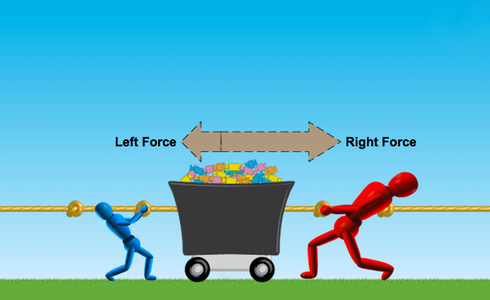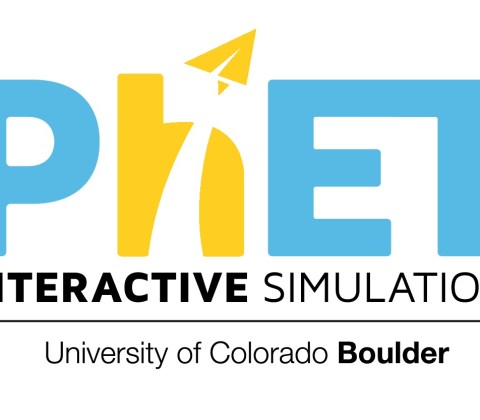Grade Level
6 - 8
minutes
15 min - 1 hr
subject
Physical Science
Activity Type:
forces, making models, Simulation
Tugging a small toy with your dog can be a lot of fun—but it’s also a great way to experiment with forces acting on an object. Forces are what scientists call the pushing and pulling on objects. In the photo at left, the boy and the dog are both applying force by pulling in opposite directions. No matter how hard we look, we can’t see how strongly the dog and the boy are pulling. In this activity, you will use a simulation from PhET Interactive Simulations to stage competitions between different size people to pull a cart full of candy. Unlike in real life, you will be able to see the strength and direction of the forces being applied to each object, which will help you make predictions about motion.
Key Concepts: motion, force, balanced forces, unbalanced forces, net force, total force, sum of forces, cause and effect, interactions, push, pull, mass
Materials:
- Computer, laptop, tablet, or mobile device with an up-to-date web browser
- The free simulation Forces and Motion: Basics open in web browser
- Colored pencils or markers
- Paper for writing
- Optional: Forces and Motion Graphic Organizer (pdf version)
Procedure:
1. Look at the pictures below of two people pulling on a cart of candy. Which way do you think the cart will move in each of the pictures below? Explain your predictions using drawings and words in the Forces and Motion Graphic Organizer.
2. Go to PhET Force and Motion Basics and click “Net Force” or use the simulation window below to test your predictions in a series of trials. Try new combinations!
3. Compare the predictions that you made above to what happens to the cart of candy in each trial. If some of your predictions are not right, use a different color pencil to correct them.
4. Try more trials using different combinations of people from the red and blue teams. Draw or talk about what you discover. You can use the Forces and Motion Graphic Organizer table to keep track of your observations. Add more rows if you want.
5. Look at your tables. What are some “rules” that you can use to make predictions about which way the cart will move? You might ask yourself questions like:
a) Does it matter that the people are red or blue? Explain your answer.
b) Does a large person always win each competition? Provide evidence to support your answer.
c) If two people are pulling on opposite sides, does the cart always stay still? Explain your ideas.
d) Does it matter what part of the rope a person holds? Provide evidence to support your answer.
e) How does the “Sum of Forces” help you?
Further Exploration: More On Forces
Try using the PhET Force and Motion Basics – “Motion“ screen to explore the impact of mass on the speed of a pushed object, such as a refrigerator, crate, or person:
1. What happens to the crate when you use the person to push it?
2. What is different if the person pushes more?
3. What do you notice if the person pushes against the crate, opposite to the direction that the crate is moving?
4. Compare pushing one crate to pushing two crates.
What differences and similarities do you notice?
5. Try some of the other objects like the girl or the man. Describe a few things you discovered and new things you learned.
Related Links:
Ready for more? Explore applied, friction, and total forces in this extension from PhET Simulations here
Check out these miniature masters of force and motion in this SciFri video:
“Mini Speed Demons” produced by Flora Lichtman
Next Generation Science Standards:
- Performance Expectations: 3-PS2-1, 3-PS2-2, MS-PS2-2
- Disciplinary Core Ideas – PS2.A: Forces and Motion; PS2.B: Types of Interactions
- Crosscutting Ideas: Cause and effect, Patterns; Stability and Change
- Practices: Asking Questions and Defining Problems, Constructing Explanations and Designing Solutions, Engaging in Argument from Evidence, Analyzing and Interpreting Data, Planning and Carrying Out Investigations
Meet the Writer
About PhET Interactive Simulations
PhET Interactive Simulations at the University of Colorado provides over 130 free interactive math and science simulations that are based on extensive education research and support more effective and engaging education.

